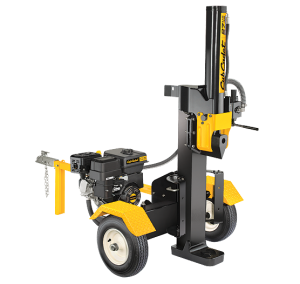 Cub Cadet’s LS 27 log splitter is an excellent option for homeowners looking to maintain their own outdoor spaces or make their own firewood. The hydraulic equipment is among the most powerful and efficient options on the market, but it also requires quite a bit of knowledge in order to be operated safely and effectively. By following a few key tips pertaining to log splitter operation, equipment owners can stay safe, keep their equipment in great shape, and maximize its power when creating firewood or taking on other maintenance tasks outside the home.
Cub Cadet’s LS 27 log splitter is an excellent option for homeowners looking to maintain their own outdoor spaces or make their own firewood. The hydraulic equipment is among the most powerful and efficient options on the market, but it also requires quite a bit of knowledge in order to be operated safely and effectively. By following a few key tips pertaining to log splitter operation, equipment owners can stay safe, keep their equipment in great shape, and maximize its power when creating firewood or taking on other maintenance tasks outside the home.
Staying Safe: Tips for Safe Log Splitter Use
Safety is a key part of log splitter operation, maintenance, and transportation. To start, make sure that the equipment is not suffering from any hydraulic fluid leaks. This process should be performed with a strong piece of cardboard, instead of bare hands, and operators should wear protective gloves during the process as well. In addition to checking for leaks, it’s a good idea to check fuel levels and inspect the log splitter for any damage or defects that could cause harm during use. Remember, the log splitter should only be used by one person at a time; no operator should be under 16 years of age, and all people using or in close proximity to the log splitter should be familiar with the full instruction manual that comes with the equipment.
A Quick Guide to Operating Positions
The key to safe and effective log splitter use is to make sure the equipment is properly setup in the right position. To get started, find a flat, dry area that can host the log splitter. Next, block both of the wheels and arrange the blower in either the upright or horizontal positions as required. The vertical position requires pulling out the horizontal beam lock, positioning the splitter vertically, and then replacing the lock to keep the blower locked into position during use.
Using the Control Handle
The log splitter’s control handle is the mechanism that actually controls the wedge, which splits logs while the engine is turned on. This control handle has three key positions. To split a log, first pull the handle back to raise the wedge. Next, push the control handle forward to “drop” the wedge and split the log. Once the log has been split, return the handle to the “neutral” or upright position, and remove the split log from the log splitter. To split another log, pull the handle back, raise the wedge, and then push the control handle forward. Repeat as necessary.
Transporting the LS 27 Log Splitter
The log splitter should not be transported between locations when it’s in the vertical position. Instead, remove the lock pin and return the splitter to the horizontal position before relocating the equipment. Next, remove both the spring clip and clevis pin from the log splitter’s jack stand. Move the jack stand into position so that it supports the tongue, and then secure the jack stand using the hardware that was previously removed. Use a vehicle with the proper Class I towing hitch to move the equipment to its new location as needed.
Quick Tips for Effective Operation
Routine operation of the LS 27 log splitter can be made easier by following a few quick tips and hints. Generally, these can be split into two key categories: things to do and things not to do.
What to Do
– Always use clean hydraulic fluid, and make sure to use new fluid frequently to keep the log splitter in good condition.
– Make sure to bleed the air out of all hoses prior to operating the equipment.
– Split wood only along the grain for best results, and to avoid damage to the equipment.
What Not to Do
– Never attempt to cut wood across the grain, as this may damage the wedge and strain the engine.
– Never operate with air in the hydraulic system and hoses.
– Never operate the log splitter through the relief valve for more than 5 seconds at a time.
– Don’t use the log splitter when the fluid is below 20 degrees or above 150 degrees Fahrenheit
– Don’t remove partially split wood from the equipment while it’s operating.
Get OEM Cub Cadet Log Splitter Parts at CubParts.com
Cub Cadet offers a wide assortment of OEM replacement parts for log splitters like the LS 27, which makes it easy to keep the equipment in top condition throughout the year. Even better, OEM parts adhere to Cub Cadet’s stringent quality assurance standards, which means they’ll likely fit better and last longer. At CubParts.com, log splitter owners can search for available replacements by their part number, the log splitter’s model number, and the engine under the hood, which makes equipment maintenance easy for even the novice equipment owner.
